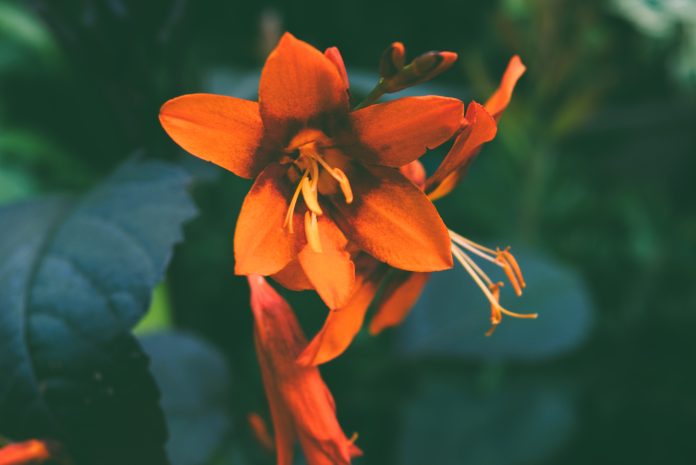Here’s a step-by-step guide on how to grow Crocosmias in the UK
Crocosmias, commonly known as montbretia, are vibrant and attractive perennial plants that produce colorful flowers. They are relatively easy to grow in the UK and thrive in well-drained soil and a sunny location.
Choose the Right Variety:
There are several varieties of Crocosmias available, each with its own unique flower color and size. Choose a variety that suits your garden’s aesthetic and your preferences.
Top Crocosmia Varieties
Classic and Reliable Varieties
- ‘Lucifer’:
- Bright, fiery red flowers.
- Tall (up to 120 cm/4 ft).
- Hardy and widely grown for its striking color and vertical accent.
- Flowers in mid to late summer.
- ‘Emily McKenzie’:
- Rich orange flowers with a contrasting red throat.
- Medium height (60-90 cm/2-3 ft).
- Compact and great for borders.
- Flowers in late summer.
- ‘George Davison’:
- Soft, golden-yellow flowers with a hint of apricot.
- Medium height (75 cm/2.5 ft).
- Delicate and elegant, ideal for brightening up borders.
- Flowers in mid to late summer.
- ‘Solfaterre’:
- Warm, soft orange flowers with bronze-tinted foliage.
- Medium height (60-80 cm/2-2.5 ft).
- Excellent contrast against green-leaved varieties.
Compact Varieties (For Smaller Gardens)
- ‘Jackanapes’:
- Bright orange flowers with a yellow center.
- Compact (45-60 cm/1.5-2 ft).
- Good for containers or smaller beds.
- ‘Fire Jumper’:
- Rich orange flowers with a bright yellow throat.
- Compact (60 cm/2 ft).
- Blooms prolifically and has a tidy habit.
- ‘Walberton Yellow’:
- Cheerful yellow flowers with compact growth.
- Ideal for small borders or as edging plants.
For Dramatic Impact
- ‘Hellfire’:
- Deep red flowers, darker than ‘Lucifer.’
- Tall (up to 120 cm/4 ft).
- Adds a moody, intense look to borders.
- ‘Severn Sunrise’:
- Large, peachy-orange flowers.
- Medium height (75-90 cm/2.5-3 ft).
- Great for creating warm, sunny displays.
- ‘Golden Fleece’:
- Bright yellow flowers with a sunny disposition.
- Medium height (70-90 cm/2.5-3 ft).
- Vibrant and cheerful.
Choosing the Best Variety
- For Height: ‘Lucifer’ and ‘Hellfire’ are excellent tall varieties.
- For Smaller Gardens: Go for compact options like ‘Jackanapes’ or ‘Fire Jumper.’
- For Unusual Foliage: ‘Solfaterre’ offers bronze foliage for contrast.
- For Yellow Shades: ‘George Davison’ and ‘Golden Fleece’ are stunning options.
By mixing and matching varieties, you can create a layered display of colors and heights that flower over an extended period. Crocosmias are hardy, easy to grow, and perfect for adding a tropical flair to your garden.
Select a Suitable Location:
Crocosmias prefer full sun but can tolerate partial shade. Choose a location in your garden that receives at least 6 hours of direct sunlight per day.
Prepare the Soil:
Crocosmias thrive in well-drained soil. They are not too fussy about soil type but prefer it to be slightly acidic to neutral. If your soil is heavy or tends to retain water, consider adding organic matter, such as well-rotted compost, to improve drainage.
Planting:
Plant Crocosmia corms (similar to bulbs) in the spring, after the danger of frost has passed. Plant them about 3-4 inches (7.5-10 cm) deep and 6 inches (15 cm) apart. If you are planting more than one corm, space them at least 12 inches (30 cm) apart.
Watering:
Water the newly planted corms thoroughly and keep the soil consistently moist until they establish roots and begin to sprout. Once established, Crocosmias are relatively drought-tolerant.
Mulching:
Apply a layer of organic mulch, such as bark or compost, around the base of the plants to retain moisture and suppress weeds. This is particularly important during the growing season.
Fertilizing:
Crocosmias generally don’t require a lot of fertilization. However, you can apply a balanced, all-purpose fertilizer in the spring when new growth begins. Follow the package instructions for application rates.
Staking:
Tall varieties of Crocosmias may benefit from staking to prevent them from flopping over. Place stakes in the ground early in the growing season, and tie the plants to the stakes as needed.
Deadheading:
Remove spent flowers to encourage continuous blooming and to prevent self-seeding, as Crocosmias can be prolific seeders.
Dividing:
Every few years, consider dividing crowded clumps of Crocosmias. This helps rejuvenate the plants and encourages better flowering. The best time to divide them is in the spring or early autumn.
Overwintering:
In the UK, Crocosmias are generally hardy, but in particularly harsh winters, a layer of mulch around the base of the plants can provide additional protection.
By following these steps, you can enjoy the beautiful and vibrant flowers of Crocosmias in your UK garden.




